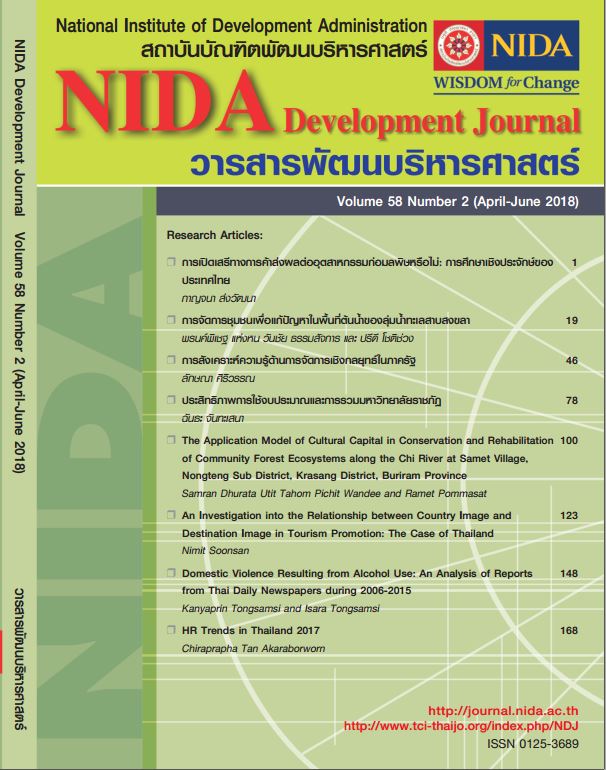The Application Model of Cultural Capital in Conservation and Rehabilitation of Community Forest Ecosystems along the Chi River at Samet Village, Nongteng Sub district, Krasang District, Buriram Province.
Main Article Content
Abstract
This study is a participatory action research (PAR) which data were collected through in-depth interview, group discussion, field trips, holding problem analysis meeting with the community, brainstorming, and participatory observation. The results showed that the application of cultural capital in the conservation and rehabilitation of the community forest ecosystems along the Chi River was divided into 3 following plans: 1) Development plan on society, tradition, and culture consisting of: (1.1) establishing understanding and a wildfire prevention system with forest utilizers, (1.2) organizing wildfire prevention activities every year, and (1.3) applying human capital to community forest conservation and rehabilitation; 2) Management plan of forest resource and community food resources consisting of: (2.1) applying belief of Pu-ta ( the ghost village of ancestors) to the conservation and rehabilitation of the forest ecosystems, (2.2) providing areas for food resources within the forests, (2.3) organizing activities of afforestation and tree ordination; and 3) Community economy management plan for developing capacity of producers producing food from forest products: standardizing the production of Tam-Piang Songkrueng (processed bamboo shoots) with hygienically good taste.
Article Details
References
Bourdieu, P. (1984). Quoted in Grisworld, W. 2004 :Cultures and Societies in a Changing
world. Thousand Oaks: Pine Forge Press.
BuddhadasaBhikkhu.(1972). Ithappajayata (Specific Conditionality): Saturday's
lecture in Moklaphalaram Garden.Bangkok :Pranakorn Printing. [In Thai].
Buriram Provincial Forest Conservation Centre. (2013). Map of the forest community along
the river of Chi River of Samet village. Buriram.[In Thai].
Biriram Provincial Forest Cooperation Center. (2013). Map of Community Forest Area along the Chi River at Samet Village. Biriram : Biriram Provincial Forest Cooperation Center
Ganjanapan.(2000). The Community Dynamic of Natural Resources Management :
Situation in Thailand.Bangkok : The Thailand Research Fund (TRF).[In Thai].
Grisworld, W. (2004).Cultures and Societies in a Changing World.ThousandOaks: Pine
Forge Press.
Keawtep, K. &Hinwiman, S. (2008). Theoreticians in Political Economy and Communication Studies.Bangkok: Bhappim Press.[In Thai:].
Patmasirawat, D. (2006). Survey of knowledge Status and Ways of Developing
Cultural Capital and Local Wisdom for Human Resource Development.
Research report: National Economic and Social Advisory Council.
Phongphaibun, (2001). The Structure and Dynamic of Southern Culture and
Development.The Thailand Research Fund.[In Thai].
Phongphit, (2003). Life Plan, Community Economy.Bangkok :Phumpanyathai.[In Thai]
Puntasen, (1996). A Research Report on Forest Preservation and the Increase of
Green Areas by Community Participation.Bangkok : Thailand Environment
Institute.[In Thai].
Tahom, U. Wandee, P. and Dhurata, S. (2014).Local Cultural and Wisdom Capital of Tama Community Buriram Province for Promoting Participation in Natural Resources and Environmental. Journal of Environmental Management.Vol.11 No.2/2014.[In Thai].
Tahom,U., and Dhurata, S. (2016). The Application of Local Cultural Knowledge in Conserving
Community Forest along the Chi River In The Ban Mara Community of NongTeng Sub-
district, Krasung District, Buriram Province Thailand. Journal ofSocialDevelopmemt
Vol.18 No.2/2016. [In Thai].
Tripitaka : Thai version, Mahachulalongkornrajavidyalaya University. (1999). TheVinaya
Pitaka, Volume 4 : Part One.Bangkok :Mahachulalongkornrajavidyalaya
University.[In Thai].

